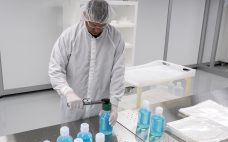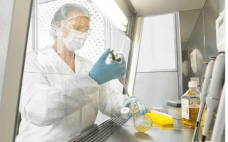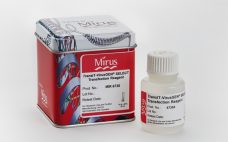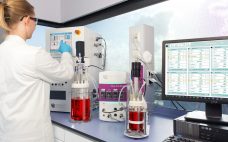This webcast features: Eric Isberg, Vice President, Life Sciences, Savillex Container integrity is critical when storing and shipping cell therapy products to ensure sterility. The security and durability of the container sealing region(s) should be weighed against usability of the container in clinical settings common to cell therapies. A study was performed to evaluate and quantitatively measure the associated leak rate for the container closure integrity of fluoropolymer bottles per USP <1207> Package Integrity Evaluation – Sterile Products using helium…
Author Archives: BPI Contributor
MAb Quantitation: Protein A HPLC vs. Protein A Bio-Layer Interferometry
Rapid, accurate and cost-effective quantitation of monoclonal antibodies (MAbs) is essential for bioprocessing. High Pressure Liquid Chromatography (HPLC) and the Octet® are some of the commonly used techniques for MAbs titer determination. To ensure MAbs purification column efficiency, the dynamic binding capacity (DBC) of Protein A for Mab can be determined by loading feedstock onto the column until binding sites for the MAb become saturated and MAb begins to break through. An assessment of the relative merits of Protein A…
Why Choose Eurofins BioPharma Product Testing?
For all stages throughout the development, manufacturing and release of your biological product, Eurofins BioPharma Product Testing offers comprehensive, fully CGMP-compliant Viral Clearance Services. We have two dedicated clearance suites for extensive capacity and timely execution and reporting of your study results. And all of our assays are fully validated to meet ICH Q2 requirements. Why Choose Eurofins BioPharma Product Testing? We bring together leading experts in the industry with extensive scientific and regulatory experience. By supporting you from study…
The Viscosity Reduction Platform: Viscosity-Reducing Excipients for Protein Formulation
Protein viscosity is one of the major obstacles in preparing highly concentrated protein formulations suitable for subcutaneous (subQ) injection. Highly viscous protein solutions would require a significant force to be applied to the syringe for injection. As a result, the patient could experience a considerable amount of pain. In many cases, injectability would not be possible. When characterizing protein viscosity behavior, one can differentiate two different concentration regimes. At very low concentrations below about 75 mg/mL, proteins are rarely viscous.…
Optimized Expression Systems for Increased Productivity in CHO DG44 Based Cell Line Development
This webcast features: Dr. Rathangadhara Nammalwar, Team Lead, Cell Line Development for Protein-Based Therapeutics, Sartorius The Global Cell Line Development (CLD) services market is growing at an unprecedented pace. In 2020, the global revenues were about $700 million and are estimated to reach nearly $1.7 billion by 2028. Chinese hamster ovary (CHO) cells have been the most preferred host cell line for those CLD services, and they alone generated more than 50% of the global revenue in 2020. Key success…
Efficient and Scalable GMP Manufacture of AAV and LV with TransIT-VirusGEN® Reagent and Enhancers
This webcast features: Leisha Kopp, Applications Scientist, Mirus Bio Recombinant adenoassociated virus (AAV) and lentivirus (LV) are essential components of many gene and cell therapies designed to treat and potentially cure a vast array of acquired and heritable diseases. Thus, the need for large-scale manufacture of safe and effective viral vectors for the development of biotherapeutics has never been greater. In this webinar, we will examine critical optimization strategies that lead to simplified, defined workflows and enable higher AAV and…
Accelerating Discoveries for Viral Biology and Host Immunity with Advanced Cell Analysis Solutions
This whitepaper summaries recently published studies that incorporated the Incucyte® Live-Cell analysis platform and iQue® 3 Advanced High-Throughput Flow Cytometry. These state-of-the-art technologies were used to simplify workflows and provide rapid analysis solutions and enhanced throughput, aiding the discovery of new insights on the host-pathogen life cycle throughout the course of infection. Post-infection, these platforms were leveraged to monitor exposure, assess immune protection, and accelerate the development of anti-viral small molecules, neutralizing antibodies, and vaccines. The Incucyte® platform offers automated…
Cell Media Analysis: A Critical Piece of the Bioprocessing Puzzle
This webcast features: Graziella Piras, Bioprocess Segment Director, 908 Devices Cell culture medium remains a key component of traditional monoclonal antibody (mAb)-based biologics as well as newer modalities such as gene and cell therapies manufacturing. As such, cell culture media development and optimization continue to be an important focus for the biopharmaceutical industry. Increased analytical capabilities have provided new insights into the relationship between cell culture media, the cells they support, and ultimately the outcome of the final product. That greater insight offers more…
Scaling and Stirring: Success Factors in Scale Up with Single-Use Benchtop Bioreactors
This webcast features: Cristina Bernal Martinez, Applications & Support Engineer, and Ann D’Ambruoso, Manager, Product Applications and Marketing, Getinge Single-use systems allow for a faster and easier workflow while simultaneously reducing the risk of errors and contamination in the development process. Nonetheless, fundamental bioreactor principles must be understood to correctly scale up in single-use bioreactors. Learn about the design factors in Applikon’s single-use bioreactors and review common scale-up strategies based on tip speed, power input, and kLa. Furthermore, shear stress…
Using Bio-Layer Interferometry for A Fast and High Precision Influenza Vaccine Potency Assay
A fast and accurate determination of vaccine titer during manufacturing is important in understanding vaccine development process performance, and for correctly scaling each process step. The Single Radial Immunodiffusion (SRID) technique has been the most commonly used technique for vaccine titer determination. However, SRID is time consuming and generally exhibits poor precision. An alternative assay that can speed up the analysis process and provide accurate and precise potency data on different vaccine strains is therefore desirable. The Octet® platform’s Bio-Layer…










